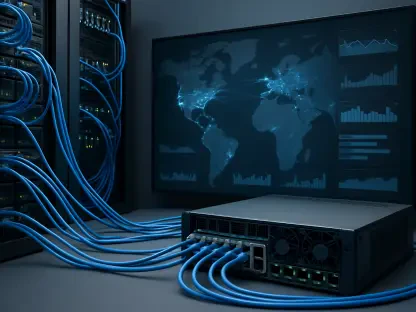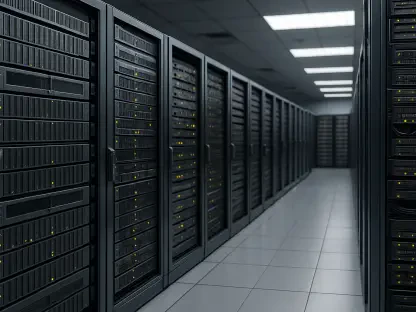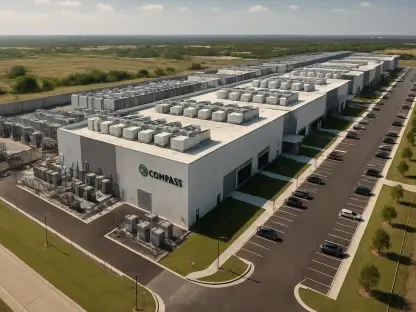In the fast-paced realm of enterprise technology, artificial intelligence (AI) has emerged as a transformative force, with computational demands growing at an astonishing rate—some estimates suggest that AI workloads will double every two years through 2027, placing immense pressure on infrastructure providers to deliver solutions that can handle vast data sets and complex algorithms without compromising efficiency. Dell Technologies has stepped into this arena with a series of updates to its AI infrastructure portfolio, unveiled at the Supercomputing 25 conference, aiming to address these escalating needs. This review dives into the specifics of Dell’s latest hardware, software integrations, and strategic collaborations, evaluating their potential to redefine enterprise AI deployments.
Key Hardware Advancements for AI Performance
High-Capacity Network Solutions
Dell has introduced two formidable network switches, the PowerSwitch Z9964F-ON and Z9964FL-ON, each boasting a staggering switching capacity of 102.4 Tb/s. These devices are engineered specifically for the intricate demands of AI fabrics, ensuring seamless connectivity across large-scale systems. Their design prioritizes high data throughput, a critical factor for organizations managing extensive AI training and inference tasks.
Beyond raw capacity, these switches address the need for reliability in environments where downtime can cost millions. They facilitate robust data flow, minimizing bottlenecks that often plague AI workloads involving massive datasets. This hardware positions Dell as a serious contender in supporting the backbone of modern AI architectures.
GPU-Intensive Server Designs
A standout in Dell’s lineup is the PowerEdge XE8712 server, which offers unparalleled GPU density by supporting up to 144 Blackwell-based GPUs per rack. This server, available since early this year, integrates advanced tools such as the Integrated Dell Remote Access Controller (iDRAC) and OpenManage Enterprise for real-time system health monitoring. Additionally, features like thermal management and rapid leak detection in liquid-cooled setups enhance operational uptime.
The emphasis on density and monitoring reflects an understanding of the intense computational needs of AI applications. By packing significant power into a standard rack, Dell enables enterprises to maximize space efficiency while maintaining performance, a crucial advantage in data center environments where real estate is at a premium.
Diverse Server Offerings for Varied Needs
Complementing the GPU-focused solutions are the AMD Instinct-powered PowerEdge XE9785 and XE9785L servers, tailored for high computational AI tasks. Alongside these, the Intel-powered PowerEdge R770AP, equipped with Intel Xeon 6 processors, offers an air-cooled option optimized for parallel processing and reduced memory latency. These platforms cater to a spectrum of enterprise requirements, from cutting-edge AI model training to traditional high-performance computing.
The variety in server configurations demonstrates Dell’s intent to provide flexible solutions that can adapt to different workload profiles. Whether an organization prioritizes GPU acceleration or CPU-driven tasks, Dell’s portfolio ensures there is a fit-for-purpose system, enhancing its appeal across diverse industries.
Strategic Collaboration with Nvidia
Dell’s deepened partnership with Nvidia forms a cornerstone of its AI strategy, integrating advanced software frameworks to boost performance. By combining Dell’s ObjectScale and PowerScale storage solutions with Nvidia’s NIXL library and Dynamo framework, the collaboration achieves scalable KV Cache storage and a remarkable 1-second Time to First Token (TTFT) at a full context window of 131K tokens. This performance leap significantly outpaces standard models, reducing infrastructure costs.
Moreover, the Dell AI Factory with Nvidia introduces the Dell Automation Platform, providing IT teams with validated AI workload blueprints. This initiative focuses on secure and repeatable deployments, addressing the often daunting complexity of AI integration. The synergy between Dell’s hardware and Nvidia’s accelerated computing expertise creates a powerful ecosystem for enterprise AI.
This partnership not only enhances technical capabilities but also positions Dell to leverage Nvidia’s market leadership in GPU technology. Such alignment ensures that Dell’s solutions remain at the forefront of innovation, offering clients a competitive edge in deploying AI at scale.
Practical Applications in Enterprise Settings
Dell’s AI infrastructure finds relevance across a broad spectrum of industries, from data analytics to scientific research. In sectors like healthcare, where AI models analyze vast amounts of patient data for predictive insights, Dell’s high-density GPU servers facilitate rapid processing. Similarly, in financial services, these systems support real-time fraud detection through machine learning algorithms.
Specific use cases, such as large-scale AI model training, benefit immensely from Dell’s advanced storage and server solutions. The ability to handle enormous datasets with minimal latency allows organizations to iterate faster on model development, a key factor in maintaining a competitive advantage.
Additionally, Dell’s focus on automation and pre-validated blueprints simplifies the adoption process for enterprises. Companies lacking deep AI expertise can rely on these tools to streamline deployment, reducing both time and risk associated with complex infrastructure setups.
Challenges in Implementing AI Infrastructure
Despite the impressive capabilities, deploying Dell’s AI solutions comes with notable challenges, including substantial upfront costs. High-end hardware like the PowerEdge XE8712 demands significant investment, which may deter smaller enterprises or those with constrained budgets from immediate adoption.
Integration complexities also pose hurdles, as aligning new infrastructure with existing systems requires technical expertise that not all organizations possess. Scalability across diverse workloads remains a concern, particularly when addressing GPU memory limitations that can bottleneck performance in certain AI tasks.
Dell is actively working to mitigate these issues through enhanced automation tools and strategic partnerships. By offering validated solutions and support frameworks, the company aims to lower the barrier to entry, though the path to seamless enterprise-wide adoption still requires careful navigation.
Future Prospects for AI Infrastructure Development
Looking ahead, Dell’s trajectory in AI infrastructure suggests a focus on even greater hardware density and software automation. As demand for edge AI and hybrid cloud environments grows over the next few years, Dell is likely to adapt by enhancing its solutions for decentralized computing and integrated data management.
Emerging trends point toward a need for infrastructure that supports real-time AI processing at the edge, where latency is critical. Dell’s ongoing innovations could position it to address these requirements through compact, high-performance systems tailored for distributed environments.
The long-term impact of these advancements may solidify Dell’s role as a leader in the enterprise AI market. By continuously evolving its offerings to meet both current and anticipated demands, Dell stands to shape how organizations leverage AI for transformative outcomes.
Final Thoughts and Next Steps
Reflecting on Dell’s recent strides in AI infrastructure, this review highlights a robust portfolio of hardware and strategic alliances that tackle the intense demands of modern AI workloads. The introduction of high-capacity switches and GPU-dense servers, coupled with a powerful collaboration with Nvidia, marks significant progress in performance and scalability.
Moving forward, enterprises considering Dell’s solutions should prioritize assessing their specific workload needs against the available hardware options to ensure alignment. Exploring the automation tools and validated blueprints offered through the Dell Automation Platform could ease integration challenges, providing a smoother transition.
Additionally, keeping an eye on Dell’s adaptations to edge computing trends will be crucial for organizations planning long-term AI strategies. Engaging with Dell’s support ecosystem to address cost and expertise barriers could unlock the full potential of these cutting-edge technologies, paving the way for innovative applications in the years ahead.









